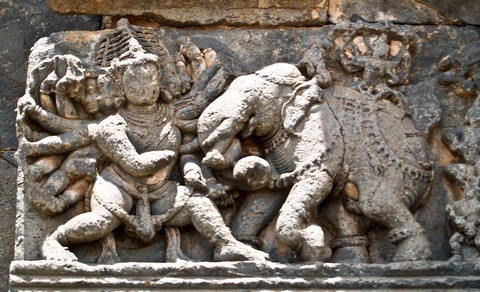
Kumbhakarna the rakshasa out for a stroll.
The third of our giants who grew from the ground are the Muans. The series starts here.
Muans ( a term made up well after the fact) are a race of supernatural immortals native to southeast Asia. Their lost history informs the legends and myths behind the Asura and Devas and Jinn and Oni of more recent human cultures.
The term comes from the pseudo-scholarly work of Col James Churchward at the end of the 19th century. While he was in error about just about everything in his speculative account of a prehistoric south-pacific lost continent, we have appropriated the name anyway.
The lower sea levels of the late Pleistocene revealed the fertile hills of a great peninsula stretching from south-east Asia, across what is now called Oceanea, and nearly to Australia. Across these muddy hills, a large and aggressive strain of Homo Erectus concocted a civilization of sorts that we now call Mu.
That Homo Erectus inhabited this peninsula is a paleo-archaic fact. Beyond that, we speculate that they developed a civilization of sorts, and then a mighty civilization. That civilization allowed them to grow – physically – into something much larger and fiercer than their humble Homo Erectus progenitors.
Homo Erectus topped out at 6’ or so, which was enormous compared to contemporary hominid species. While they matched modern human in size, their skulls were smaller and flatter. This did not stop them from using fire and devloping a distinct style of tool making often referred to as Acheulian culture. (So if you need a name that is not Mu – there you go).
Let us imagine now that some of these fellows went beyond fire and finely chipped stone axes; that they created a genuine civilization of some sort on the muddy shores of that ice-age subcontinent. What might remain? Not much, the rising seas would not have been kind. But folklore in that part of the world goes back a looong way.
Hawaiian lore speaks of a transpacific civilization before the Polynesian culture which conquered the island around the 13th century. This civilization actually had very little structure. The people hunted and fishing, shared everything communally, and disputes were settled by the eldest among them. This speaks more of a low population density than any particular enlightenment.
Southeast Asian folklore is filled with ogre-like creatures with fangs and occasionally too many limbs or heads. These creatures were slavers and cannibals. Until you get to Hindu myth – which is never that simple.

The Asuras and Rhaksasas of Vedic myth opposed the gods (specifically they opposed Indra and his allies), and often behaved badly towards those ends, but not all were evil. Most adhered to a fairly ascetic life, and the differences between the Asuras and the gods seem mostly political.
Asuras and Raksasa are shape-shifters, and come in a bewildering variety of forms.
Let’s put this together in a single (wholly fictional) narrative:
At least a half million years ago, the advancing Acheulian civilization stumbled upon the secret of eternal life. Perhaps it was gift from Outside Forces, perhaps it was derived from purity of spirit, perhaps they developed it through science. Remember: humans got from wild wheat fields to landing on the moon in just over 5000 years.
So the Muans had biological regeneration, shape change, and dimensional manipulation (to carry some legends forward). That’s better than computers and gunpowder. Respect.
It may be that the price of eternal life was never having children. If so, it seems the Muans found a way around it, but the results might have been horribly mutated: the Oni of Japanese myth, and a tribe of descendants crossing Africa and eventually working northwards up the Atlantic to become the Fomorians.
Muans themselves lived by a strict moral code. They worshipped no gods, and indeed spat upon all supernatural notions. They fought one another, but never to the death, and serious disputes were always arbitrated by other Muans. They had an ascetic philosophy of continually improving oneself – for what else is the point of eternal life?
But Muans regarded all other human variants as little more than animals, suitable only as slaves, and occasionally food. Hece their reputation in folklore.
As the ice age ended, about 15,000 years ago, the waves would start to overtake their homeland. Crushed for resources, the Muans began to battle one another – unheard of to that point. Even so, a series of volcanic eruptions about 8000 years ago would have sealed their doom as a coherent people. The survivors wandered inland, and disappeared into myth.
SOURCES:
Mu in general:
https://redice.tv/news/the-lost-lands-of-mu-and-lemuria
Homo Erectus
http://humanorigins.si.edu/evidence/human-fossils/species/homo-erectus
http://anthro.palomar.edu/homo/homo_2.htm
http://www.nature.com/scitable/knowledge/library/homo-erectus-a-bigger-smarter-97879043
http://www.becominghuman.org/node/homo-erectus-0
Hawaii:
http://www.kahunaresearchgroup.org/case-log/legend-of-the-mu-people-hawaiis-original-inhabitants
Other Mythology
http://www.sacred-texts.com/hin/hmvp/hmvp43.htm
http://www.hindupedia.com/en/Asura
Asuras are mythological lord beings in Indian and Persian (Ariæns) texts who compete for power with the more benevolent devas (also known as suras).[1] Asuras are described in Indian texts as powerful superhuman demigods or demons with good or bad qualities. The good Asuras are called Adityas and are led by Varuna, while the malevolent ones are called Danavas and are led by Vritra.[2] Other specific sections of Asuras exist, and they are known as Daityas, Anavayas, and Raksasas.
http://www.hindu-blog.com/2010/06/difference-between-asuras-and-rakshasas.html
http://www.chinabuddhismencyclopedia.com/en/index.php/Rakshasa
http://www.ancient-origins.net/myths-legends-asia/jinn-tales-wish-masters-throughout-time-005138
Images:
2 thoughts on “The Muans (Giant Primer pt4)”